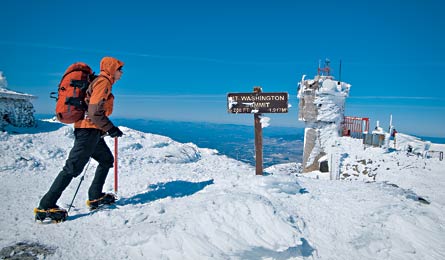Best Winter Trips: White Mountain National Forest, New Hampshire

'Mr. Freeze: Mt. Washington features ample winter challenges.'
» Snowshoe/XC Ski Winding along boulder-strewn Swift River and Kancamagus Highway, the seven-mile Lower Nanamocomuck Trail stretches from the Albany Covered Bridge to Bear Notch Road—and through an area inhabited by snow hares, bobcats, whitetail deer, and moose. For a longer day, add nine miles along the hushed and remote Upper Nanamocomuck Trail to Lily Pond. Overnight: Snowshoe 6.5 miles from Zealand Road (off US 302) to the AMC’s Zealand Falls Hut (sleeps 36). From there, daytrip to Zeacliff or Zealand Falls for bright, airy views over the Pemigewasset Wilderness.
» Ski On Washington’s eastern face, the 45-plus-degree, 1,200-foot descent of Tuckerman’s Ravine is New England’s premier backcountry route. For more vertical and fewer crowds, descend Wildcat Mountain Ski Area via the 11-mile Wildcat Valley Trail for a slalom with a 3,425-foot drop through stands of birch and spruce.
» Mountaineer Boasting beginner-to-advanced ice, Crawford Notch and Huntington Ravine are ground zero for winter climbing. Denali training: Battle snot-freezing cold and whiteout conditions on Mt. Washington’s eight-mile Lion Head route. Cairns on the treeless summit can be obscured by snowdrifts. Expert skills required.
» Resources White Mountain’s Saco Ranger Station; (603) 447-5448. Huts: Contact the AMC, outdoors.org; (603) 466-2721 Gear up Eastern Mountain Sports in North Conway, NH; ems.com